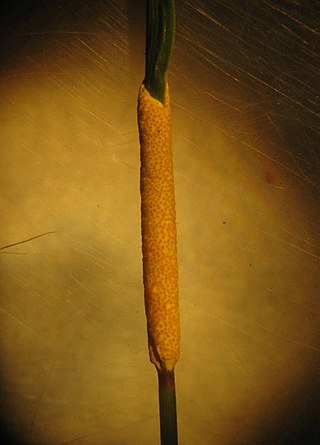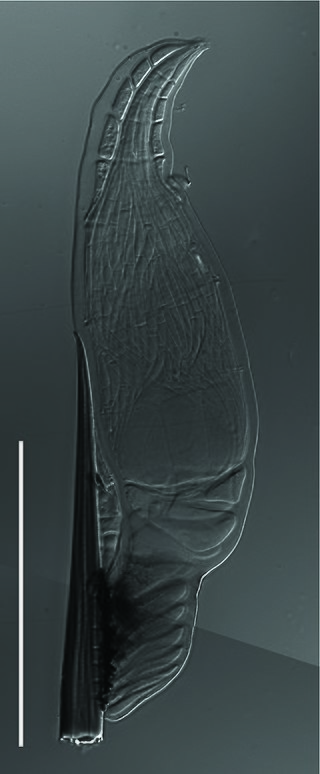
A hydrogenosome is a membrane-enclosed organelle found in some anaerobic ciliates, flagellates, and fungi. Hydrogenosomes are highly variable organelles that have presumably evolved from protomitochondria to produce molecular hydrogen and ATP in anaerobic conditions.
Members of the genus Selenomonas are referred to trivially as selenomonads. The genus Selenomonas constitutes a group of motile crescent-shaped bacteria and includes species living in the gastrointestinal tracts of animals, in particular the ruminants. A number of smaller forms discovered with the light microscope are now in culture but many, especially the large selenomonads are not, owing to their fastidious and incompletely known growth requirements.

The Orbiliaceae are a family of saprobic sac fungi in the order Orbiliales. The family, first described by John Axel Nannfeldt in 1932, contains 288 species in 12 genera. Members of this family have a widespread distribution, but are more prevalent in temperate regions. Some species in the Orbiliaceae are carnivorous fungi, and have evolved a number of specialized mechanisms to trap nematodes.

Texosporium is a genus of lichenized fungi in the family Caliciaceae. It is a monotypic genus, containing the single species Texosporium sancti-jacobi, found in the United States. The genus is characterized by microscopic features: the ascospores are coated with a layer of cells that are derived from the paraphyses. Texosporium was originally circumscribed by Josef Nádvorník in 1942, albeit the name was not validly published. In 1968, Leif Tibell and Angelica van Hofsten published the name validly. In 2020, Texosporium sancti-jacobi was added to the global IUCN Red List, where it is classified as endangered.

Polyozellus is a fungal genus in the family Thelephoraceae, a grouping of mushrooms known collectively as the leathery earthfans. Previously considered a monotypic genus, it now contains the Polyozellus multiplex species complex. The genus name is derived from the Greek poly meaning many, and oz, meaning branch. It is commonly known as the blue chanterelle, the clustered blue chanterelle, or, in Alaska, the black chanterelle. The distinctive fruit body of this species comprises blue- to purple-colored clusters of vase- or spoon-shaped caps with veiny wrinkles on the undersurface that run down the length of the stem.

Tuber is a genus in the fungal family Tuberaceae, with estimated molecular dating to the end of the Jurassic period. It includes several species of truffles that are highly valued as delicacies.
Phellinus sulphurascens is the Douglas-fir species of the fungus genus, Phellinus. It was recently recognized as a distinct species from Phellinus weirii. Both were historically thought to be the same, but genetic tests suggested that the two species were distinct. The form first described as P. weirii is the Cedar form.
Dissoderma paradoxum, which has the recommended English name of powdercap strangler in the UK, is a species of fungus in the family Squamanitaceae. It is a parasitic fungus that grows on the fruit bodies of another fungus, Cystoderma amianthinum. The species was first described as Cystoderma paradoxum by American mycologists Alexander H. Smith and Rolf Singer in 1948, based on specimens collected in Mount Hood National Forest in Oregon. Cornelis Bas transferred the species to the genus Squamanita in 1965. Recent molecular research, based on cladistic analysis of DNA sequences, has however shown that the species does not belong in Squamanita sensu stricto but in the related genus Dissoderma. The species occurs in both North America and Europe.
Lichenothelia is a genus of fungi in the family Lichenotheliaceae.

Zoophagus is a genus of zygomycete fungi that preys on rotifers and nematodes. It was established in 1911 by Sommerstorff, who originally considered it to be an oomycete. It is common in a variety of freshwater habitats, such as ponds and sewage treatment plants.

Microglossum viride is a species of fungus in the family Geoglossaceae. They are commonly called green earth tongues.
Cystoderma granuliferum is a species of fungus in the family Squamanitaceae. It is found in the Amazonian region of Ecuador, where it grows on the rotting wood of dicotyledons. The fungus was described as new to science in 1999 by mycologists Cornelis Bas and Thomas Læssøe. Molecular research, based on cladistic analysis of DNA sequences, has shown that it belongs in the genus Cystoderma.
Methanogens are a group of microorganisms that produce methane as a byproduct of their metabolism. They play an important role in the digestive system of ruminants. The digestive tract of ruminants contains four major parts: rumen, reticulum, omasum and abomasum. The food with saliva first passes to the rumen for breaking into smaller particles and then moves to the reticulum, where the food is broken into further smaller particles. Any indigestible particles are sent back to the rumen for rechewing. The majority of anaerobic microbes assisting the cellulose breakdown occupy the rumen and initiate the fermentation process. The animal absorbs the fatty acids, vitamins and nutrient content on passing the partially digested food from the rumen to the omasum. This decreases the pH level and initiates the release of enzymes for further breakdown of the food which later passes to the abomasum to absorb remaining nutrients before excretion. This process takes about 9–12 hours.

Sarcodontia setosa is a species of toothed crust fungus in the family Meruliaceae. It is a white rot species that is found in Europe and North America.

Trichophyton terrestre is a fungus of the genus Trichophyton.

Epichloë typhina is a haploid sexual species in the fungal genus Epichloë. It was originally described as a Sphaeria species. Today, however, it is classified in Epichloë.
Elizabeth Eaton Morse was an American mycologist. Born in Framingham, Massachusetts, she graduated from Ashland, Massachusetts, High School in 1882. For seven years she taught in elementary school before entering Wellesley College, from which she graduated with a diploma from the School of Art in 1891. After twenty years of teaching in the New York City schools Morris High School and Roosevelt High School, she returned to Wellesley College in 1924 and earned a degree in Botany in 1926. Shortly after, she registered as a part-time graduate student in the Department of Botany at the University of California, and was given storage and work space to pursue her interests in cryptogamic botany.

The Herpomycetales is an order of fungi within the class Laboulbeniomycetes. The order includes a single dioecious genus, Herpomyces, with 27 accepted species of obligate ectoparasites that are associated exclusively with cockroaches. Like the Laboulbeniales order, they produce cellular thalli. However, the thalli of Herpomyces are developmentally and morphologically unique.

Anaeromyces robustus is a fungal microorganism that lives in the gut rumen of many ruminant herbivores such as cows and sheep. Previously thought to be protozoa from their flagellated zoospores, they are biomass degraders and help the animal by breaking down carbohydrates and plant materials from the food the animal ingests. This fungus, therefore, is anaerobic and lives without oxygen. Gut fungi are dramatically outnumbered by other organisms in the microbiome; however, they are important members of the gut microbiome in ruminants and hind-gut fermenters and play a key role in digestion.
Strongwellsea is a genus of fungi within the order Entomophthorales of the Zygomycota. They are known to infect insects. Infected adult dipteran hosts develop a large hole in their abdomens, through which conidia (spores) are then actively discharged while the hosts are still alive.











